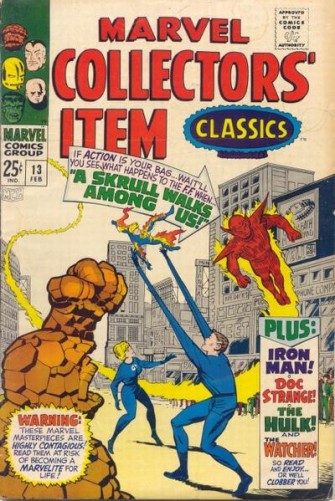 Home > CR Reviews
Home > CR Reviews Marvel Collectors’ Item Classics #13
posted August 9, 2007
Marvel Collectors’ Item Classics #13
posted August 9, 2007

 Creators:
Creators: Jack Kirby, Stan Lee, Steve Ditko, Larry Lieber, Paul Reinman, Artie Simek, Don Heck
Publishing Information: Marvel, comic book, 64 pages, 1967, $0.25
Ordering Numbers:
The amazing thing to me about 1960s Marvel isn't that Jack Kirby, Stan Lee, Steve Ditko and company could launch a line of superhero comics that were much more entertaining and lively than DC's stiffer, more classic funnybooks. That was going to be done by someone if those books stayed profitable. What's remarkable is that those books developed past that initial period of crude counterpoint to as visually sophisticated and accomplished in their scripting and storytelling as anything DC's better-paying outfit could manage. It was that move from market alternative to market rival that really put Marvel's superheroes on the map, not the various series as initially sprung from Jack Kirby's or Stan Lee's or even Martin Goodman's head. It's a story of comic book execution that too often gets told as one of character creation inspiration. An irony of today's market is that while selling their books to an audience increasingly made up of longtime fans, the sales base has almost no patience for slow growth of the kind that created the books they enjoyed in the first place.
Marvels Collectors' Item Classics has a unique pedigree in a lot of ways -- Douglas Wolk says it was the first item to label itself for collectors, and more generally Marvel's continuity-heavy comics engendered a perceived value for past stories that was a not-insignificant factor in the modern back-issues market. In issue #13 of the reprint comic, the reader sees snapshots of a number of series in development. The Fantastic Four's issue-long fight with a Super Skrull hints at the blend of comedy and science fiction yet to come, and helps nail down a useful motif of the superhero team as overmatched underdogs. An Iron Man story plays to Don Heck's strengths with a lot of figure drawing in a more sedate non-action setting and also delves slightly into the areas of espionage and Cold War politics where the comic seemed to have ambitions that never quite worked. A Dr. Strange story featuring a battle between the Sorcerer Supreme and dream-baddie Nightmare nails down one extremely effective thing that feature does: shows very simplistic, fantastic notions in a way that counts on comics' lurid qualities to ratchet up the tension. In this particular tale, the simple notion is the Unstoppable Monster. There are other comics; all of them together hint at the Marvel juggernaut of the middle 1960s. It's odd how little on display has been exploited in the years since.


